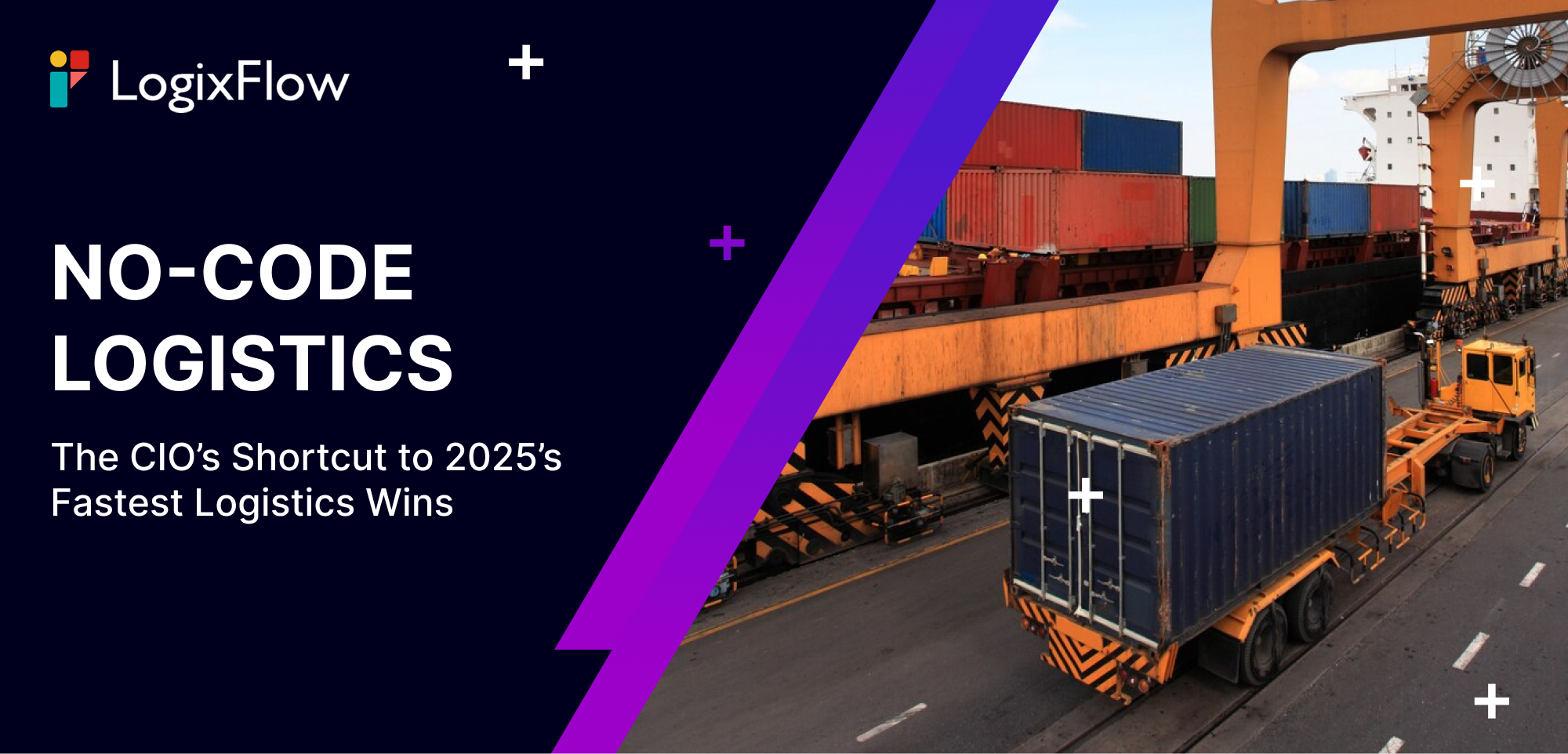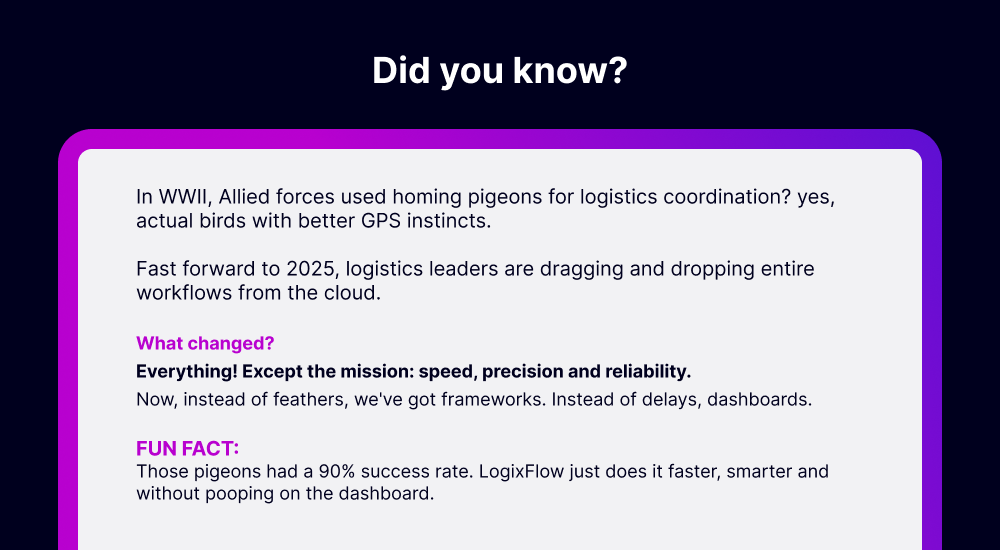
No-Code in Logistics: Why CIOs Are Making the Shift in 2025
The cardinal duty of the captain of a ship is to steer and navigate. If the captain involved himself in every minor task on board and spent his time cleaning decks or fixing engines, the ship risks drifting off course. The captain’s leadership lies in setting direction, making strategic decisions, and ensuring safe passage. The crew handles execution; the captain provides vision. A distracted captain can endanger the entire journey.
This is not just a random ship captain, this could be any leader who mixes up his strategic-driven role with task-centric roles. Here too, innovation suffers, and the business risks losing momentum in a fiercely competitive market.
In the world of logistics,
Order placed. Order dispatched. Order delivered on time – is not just a notification, but a silent ambassador of the brand to its customer and their customer.
In 2025, as logistics becomes increasingly complex and customer expectations grow sharper, CIOs are stepping into the captain’s shoes, focusing not just on operations but on authorizing the crew to steer smarter, faster and leaner.
Logistics runs on precision but ironically, its tech backbone often looks like a patchwork of aging systems, clipped together with costly integrations and slow moving IT tickets. While automation has been a motto for years, actual implementation often lags behind the demand. In 2025, this gap is narrowing rapidly, thanks to the rise of no-code platforms. What once required weeks of development and coordination with IT teams can now be built and deployed in hours by operations teams themselves. For CIOs, this shift isn’t just tactical, it’s strategic.
Packed. Shipped. Delivered. + the STRATEGY. Any ideas?
What Is No-Code In Logistics, Really?
And why is it not just a buzzword? Yes, you know no-code platforms let you build apps with drag-and-drop tools instead of actual code. But here’s what really matters:
No-code platforms let users create software applications using a visual interface, replacing complex syntax with intuitive modules, logic flows and form builders. While the term might suggest simplicity, the impact is anything but small.
Think of it as democratizing technology: the warehouse supervisor who knows exactly how goods are misplaced can now design a tracking system without writing a single line of code. No-code isn’t about replacing developers; It’s about giving devs their time back so they’re not stuck building onboarding forms for the third time this quarter.
Timeline: How No-Code Found Its Footing in Logistics
1990s: Automation was expensive, heavy and mostly a Fortune 500 toy.
2000s: ERPs and CRMs started showing up in warehouses, along with growing IT backlogs.
2010s: No-code tools knocked but the logistics team shrugged.
2020: COVID hit. Supply chains snapped. Ops teams got tired of waiting.
2025: Now? CIOs don’t ask if no-code fits, they just want to know how soon they can ship.
Why CIOs Are Leading the No-Code Charge in 2025
The captain of a ship shouldn’t involve himself in every minor task on board, his primary duty is to steer and navigate…
- Faster Execution, Fewer TailbacksTraditional IT pipelines often resemble airport security during a holiday rush, everything slows down, everyone’s frustrated and the only thing flying is time.No-code lets ops teams jump the queue, build what they need and go live without chasing IT like Nobita chasing Doraemon’s next gadget.For CIOs, it means fewer “Hey, quick question…” messages and more focus on long term strategic thinking.
- Democratization of TechNo-code allows domain experts to solve domain-specific problems.Finally, IT and ops can stop their passive aggressive email exchanges and actually build things together.Logistics teams can automate inventory updates, build vendor tracking dashboards or simplify internal audits with minimal dependencies.
- Better BudgetingHiring devs is expensive and for sure will be booked till Q4.Maintaining custom software? Even costlier. With no-code, CIOs can reduce spend on development and maintenance, and allocate budgets more effectively. It’s agility without the financial bloat.
- Continuous Innovation Without Tech DebtNo-code allows for rapid prototyping.Teams can build, test, iterate and scrap without the fear of sunk cost. You don’t have to live with bad software decisions anymore.

Logistics Use Cases That Just Make Sense
- Warehouse AutomationCreate custom workflows for order picking, real-time inventory updates and damage flagging. With triggers and notifications built-in, these workflows reduce manual effort and improve turnaround time.
- Delivery CoordinationDesign forms and dashboards that track shipments, notify customers, and flag delivery exceptions. Combine map APIs, SMS integrations and rule engines without writing backend logic.
- Vendor Audits or Employee OnboardingAutomate form collection, verification, approvals, and onboarding checklists. No-code apps ensure compliance and reduce turnaround time from days to hours.
- The Hype vs. RealityLet’s be clear: No-code isn’t some abracadabra. It won’t fix broken processes and somehow modernize your stack or make cross-team misalignment disappear. What it does do is remove a lot of the drag from building useful tools, if there’s clarity on what needs fixing and support from the top. It’s not a shortcut to better thinking. It’s a way to move faster once you’ve done the thinking.
Steering No-Code Risks
No-code platforms are a powerful tool but they come with their own set of challenges. While they simplify many processes, they might not always support complicated workflows or connect well with older systems. This can create issues when scaling or working with highly specialized processes in logistics.
Another risk to watch for is “shadow IT,” where teams build their own solutions outside of IT’s oversight. This can lead to security and integration issues if not properly managed.
Lastly, while no-code is good for automating routine tasks, CIOs should be cautious about relying on it for mission-critical systems. There’s still a need for skilled developers when complex or high-risk projects are involved. Proper control is required to make sure no-code doesn’t compromise the quality or security of the operation.
No-Code Is Easy. Falling Short Is Easier.
No-code doesn’t mean no governance. CIOs must make sure:
-
- Access Control: Define roles and permissions so that sensitive data is handled securely.
- Integration Discipline: Make sure no-code tools integrate smoothly with existing TMS, WMS, ERP, and CRM systems. Plugging a no-code tool into your ERP without a plan is like hotwiring a spaceship, yeah fun until it explodes.
- Documentation & Versioning: Just because it’s easy to build doesn’t mean it should be ad hoc. Processes still need documentation. “We’ll remember how it works” is the first line of every future IT horror story.
What the Future Holds
The CIO’s role is evolving. No longer just the gatekeeper of IT, the modern logistics CIO is an enabler, someone who empowers teams to build, iterate, and scale. In 2025, no-code is becoming the default approach to solve business problems without draining IT resources.
As talent shortages continue and the pressure for digital transformation mounts, the ability to execute quickly will define success. And those who empower execution, not just plan it, will lead the way.
Don’t Wait for Tickets
Logistics doesn’t have time to wait and neither should you. CIOs know that speed, adaptability and control are the future. LogixFlow, the no-code platform is not just nice to have, they are mission critical tools that turn tech jam-ups into bridges.
2025 belongs to the builders. And no-code is their language.
Sure, code if you want to. But in logistics, speed wins! D’you Agree?

